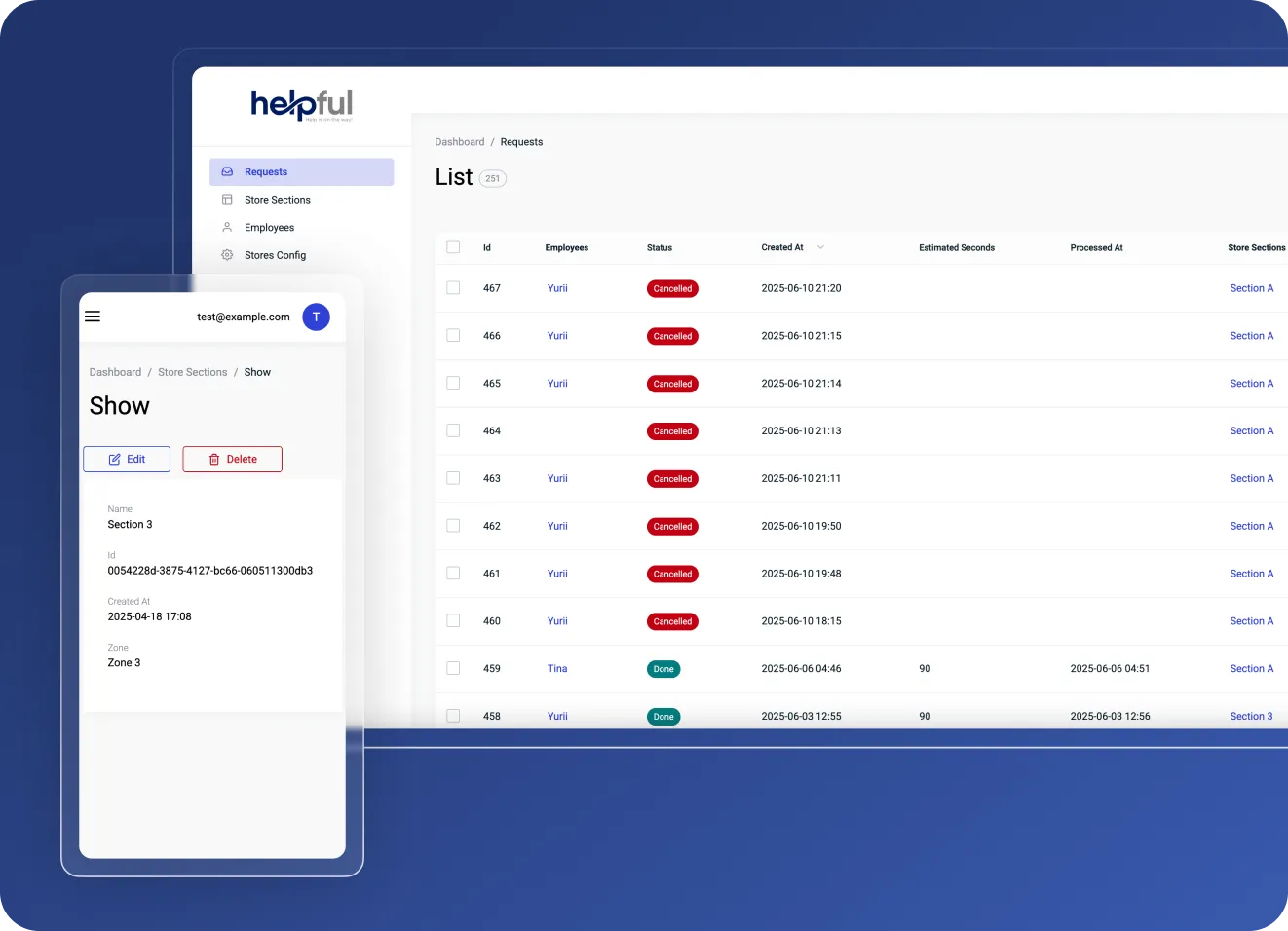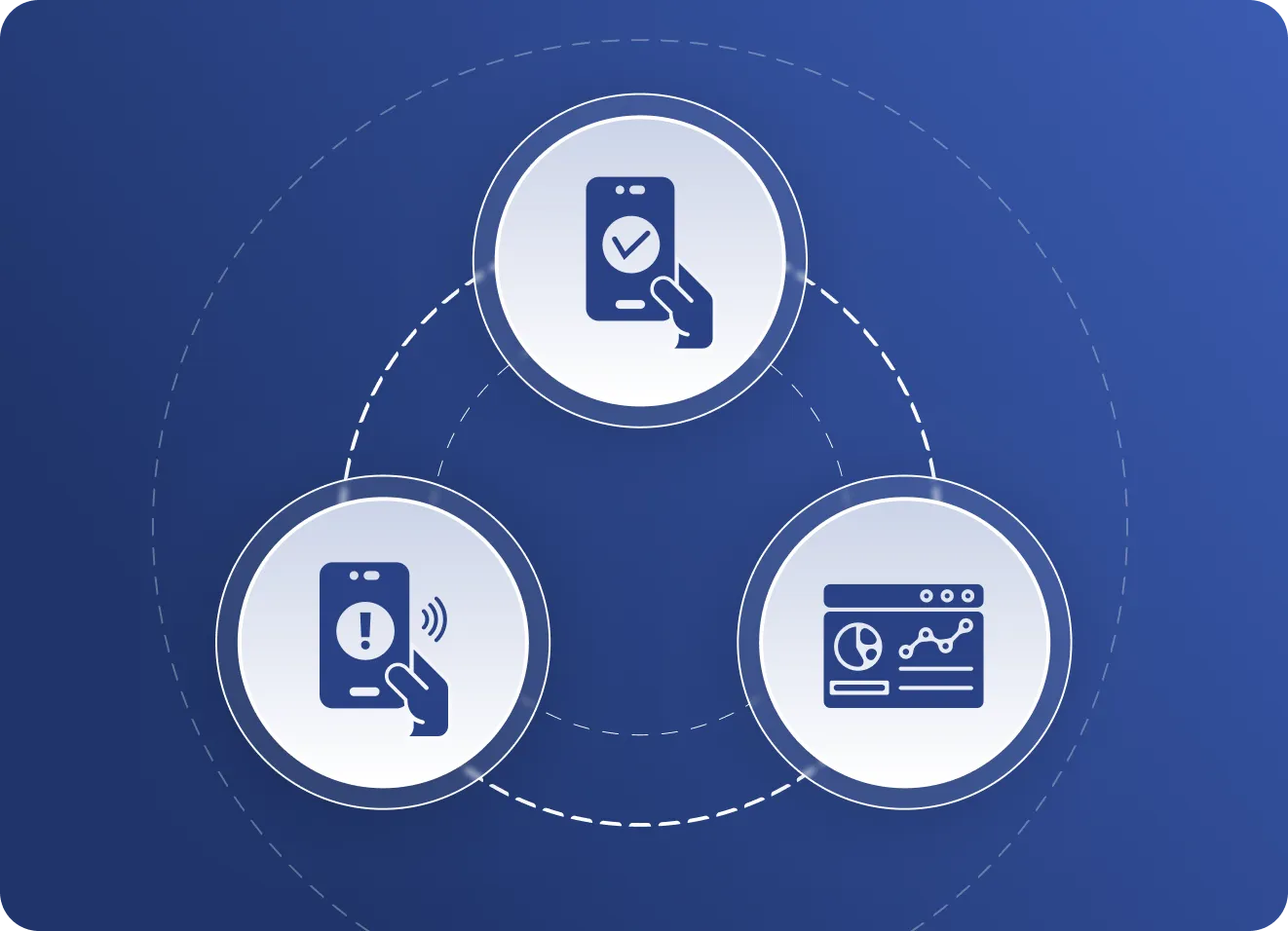Shop assistant platform: Driving investor engagement by 31% with a demo-ready PoC


Project overview
Online shopping may have grown in popularity, but almost three-quarters of U.S. retail sales still come from the brick-and-mortar channel. So, in-person store experiences still matter, and interacting with shop assistants is one of them.
Having to wander around the store looking for an available shop assistant or waiting longer than expected for assistance, however, doesn’t make for a good in-store experience. Yet, in stores with lean teams, ensuring shop assistants quickly arrive where and when they’re needed is tougher than it seems.
Where retailers saw a challenge, our client (a US-based startup) saw an opportunity. With the initial resources secured, the startup set out to create a proof of concept for the platform that would resolve this challenge.
This platform, dubbed Helpful, would enable customers to request the presence of a shop assistant via a web interface. Shop assistants would immediately get notified about the request via a mobile app.
But before the idea could become a successful platform, our client needed a solid proof of concept to validate it. The startup approached us with a request to develop its three-part solution, along with a corresponding landing page.
Services







Challenges
Our client envisioned the platform as a three-component solution. It would consist of a mobile app for shop assistants, a web interface for store customers, and a web admin dashboard for store managers. To make the desired impact on the store’s operational efficiency and customer experiences, however, the data sync had to be seamless and immediate.
Besides enabling seamless real-time data sync, we also had to ensure the proof of concept could support a growing number of users and evolve into a full-fledged product. So, scalability was also at the forefront of our minds as we selected the tech stack and designed the solution’s architecture.
Finally, like most startups, our client was operating under stringent time and budget constraints. So, we had to adapt our tech stack and timeline to those constraints.
Strategic business needs
01 Develop a proof of concept for idea validation and demo meetings
02 Minimize development time and costs with a cross-platform tech stack
03 Ensure seamless data sync between the platform’s components
04 Achieve a user satisfaction rate above 85% in early testing
05 Ensure the platform is scalable and flexible enough for future growth and development
06 Create an online presence for the product with a simple landing page
07 Get guidance on future feature implementations, user feedback collection, and KPI tracking
Technical requirements
01 Design and develop Android and iOS mobile apps for shop assistants with a cross-platform tech stack
02 Roll out the mobile apps into the testing environment (Google Play Console for Android, TestFlight for iOS)
03 Design and develop a responsive web interface for store customers
04 Design and develop a responsive web admin dashboard for store managers
05 Secure a system usability scale (SUS) score above 85 across the platform’s components
06 Ensure a task success rate above 85% for the platform
07 Bring the average data latency below 50ms for real-time data sync
08 Design and implement a landing page for the product
09 Prepare detailed handoff documentation
10 Create guidelines for using the PoC during demo meetings
We’ll develop a stable, scalable PoC that puts your product’s core value proposition front and center.

 Talk to an expert
Talk to an expert.webp)
Solutions
Following a comprehensive discovery phase and project planning, we adopted an agile approach to building the proof of concept. Thanks to our frontend, backend, and cross-platform expertise, the startup received a stable, scalable PoC consisting of three key components:
- Web interface for retail store customers
- Android and iOS mobile apps for shop assistants
- Web admin dashboard for managers
With the final versions of the three components approved by our client, we launched the web components and rolled out the mobile apps to the testing environments (Google Play Console, TestFlight).
Throughout the project, we advised our client on future development, PoC transferring, feedback collection, and KPI tracking. We also prepared comprehensive documentation to facilitate product updates and demo guidelines to help our client successfully demonstrate all the capabilities to potential customers or investors.



Web interface for customers
Thanks to this web-based product component, store visitors would be able to request a shop assistant to arrive at a specific location within the store.
We developed a simple version of it, all while making sure the interface was easy to use and navigate. Our user testing and iterative UI/UX improvements ensured a high task success rate and usability score for the interface. We also ensured its responsiveness to enable retailers to use it on a variety of devices, including tablets and large touchscreens.

Mobile app for shop assistants
This mobile app would alert shop assistants whenever their presence is required and specify where they should head.
To ensure the platform is versatile enough for retailers, we developed a cross-platform mobile app ready for use on both Android and iOS devices. At the same time, our Ionic and Supabase stack minimized development time and costs with reusable code components.
To make alerts effective, we implemented push notifications and minimized data sync latency to <50ms to make those alerts truly real-time. Our human-centered UI/UX design, while minimalistic, ensured high usability and task success rates.

Web admin dashboard for managers
As the final PoC component, this dashboard would enable store managers to add and remove shop assistants to the platform and track their responsiveness and speed.
Together with the client, we opted for making the dashboard web-based to ensure it could be easily used on any device, from a smartphone or tablet to a desktop. Our responsive design also came with intuitive navigation and high performance, as well as real-time data sync.

Seamless data sync
Helpful’s three components had to exchange data in real time. Otherwise, notifications would arrive too late to the mobile apps, and managers wouldn’t have a timely overview of the store’s operations.
So, we integrated all data sources with real-time data sync in mind and thoroughly tested data exchange for latency and reliability. As a result, the platform’s data latency remains below 50ms under various request rates, enabling all the current and future real-time capabilities.

Scalable architecture
As a forward-looking startup, our client asked us to make the platform scalable and flexible enough to support future feature updates and user base growth.
So, we designed the platform’s architecture using a modular approach. This approach will facilitate changes to the platform’s functionality both on the frontend and backend, ensuring its scalability in the long run.

Product landing page
Last but not least, we designed and developed a landing page to promote the product and drive interactions with potential customers and investors alike. Together with the demo-ready PoC, the landing page was meant to build brand visibility and trust and drive investor engagement.
We designed the single-page website to quickly communicate the main benefits of the product and highlight CTAs and other crucial visual components. At the same time, we ensured its performance, bringing down the page loading speed to below 500ms.



Tech stack




Impact
As a result of our work, our client received a stable, scalable proof of concept ready for both demo meetings and real-world use, along with a landing page to present and promote it. Our involvement helped the client reap the following benefits:
We’ll build your product’s first version using a cost-efficient tech stack that doesn’t compromise its performance or responsiveness.

 Contact us
Contact usRelated case study
Connect with us
.webp)
We are a tech partner that delivers ingenious digital solutions, engineering and vertical services for industry leaders powered by vetted talents.



.svg)










